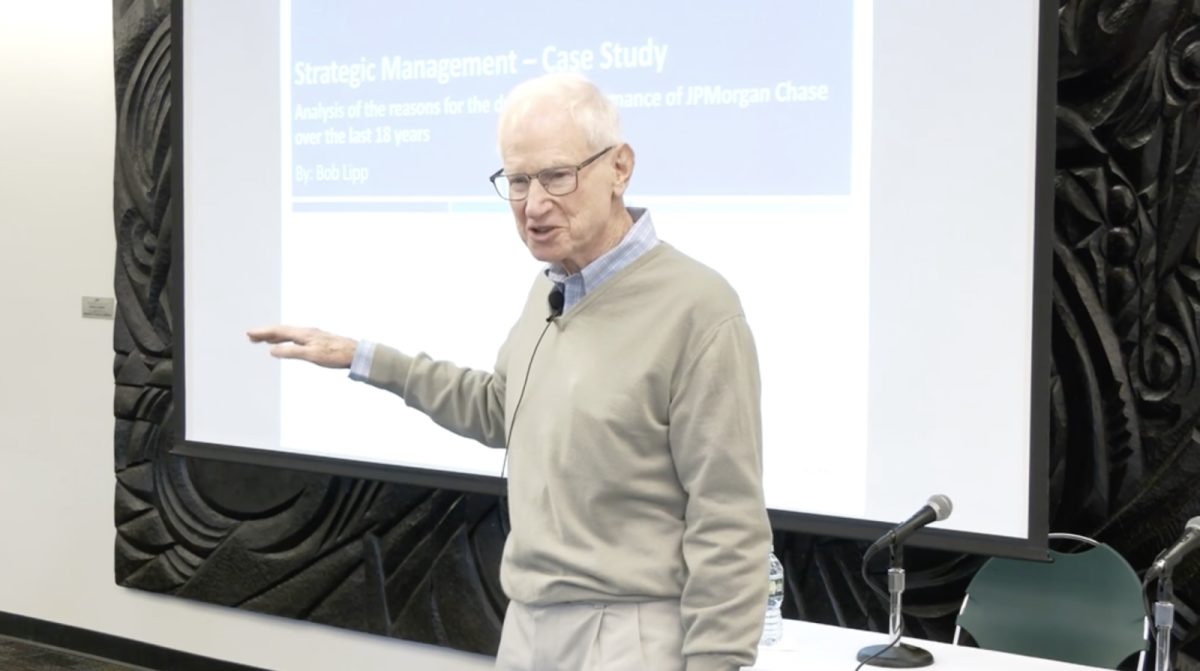The latest “Mitsui Lunchtime Forum” on Oct. 17, hosted by the Weissman Center for International Business, centered on a discussion between students and speaker Robert I. Lipp on the dramatic performance of JPMorgan Chase & Co.
Lipp discussed the management style of Jamie Dimon, Chase’s CEO since 2005. The financial institution not only overcame the 2008 financial crisis under Dimon’s leadership but is currently the leading bank in the nation and the world by market capitalization. Chase’s growth outpaced top banks in its third-quarter earnings this year.
Lipp said this was due to JP Morgan’s four themes of management focus: risk management, the “fortress balance sheet,” openness and honesty and its operating principles.
Unlike other banks, from 2004 to 2006, JP Morgan shifted its focus away from risk appetite, valuing fundamental credit risk rather than some “acceptable risk” of volatility. The bank was not deterred from market volatility as Dimon enhanced his coined “Fortress Balance Sheet” to withstand economic shocks but leave enough flexibility for deal-making.
Lipp made many comparisons between the progress of Chase and Citigroup, where he was a former vice chairman. Citigroup, once considered the U.S. bank with greater affluence, had $100 billion more market capitalization than JP Morgan Chase in 2004. Currently, Citigroup has drastically fallen behind Chase and other banks in net interest income growth and operating profit.
“Back in ’04, ’05, ’06, ’07, subprime mortgages were a great thing to do,” Lipp said. “All these banks had all these subprime mortgages, selling them and packaging them to paid pension plans and stuff like that. Then the music stopped. During 2008 to 2012, every bank in the country thought they were going to go broke.”
During the financial crisis, Chase went from $5 billion shares outstanding to $28 billion shares. Stockholders had their shares diluted in a six-for-one split. Although JP Morgan was one of the healthiest banks, because it didn’t fall victim to the subprime mortgage craze, the corporation felt compelled to rescue banks and the U.S. economy.
Nevertheless, JP Morgan Chase preserved its balance sheets and managed to generate revenue growth, outmaneuvering Citibank and other competitors. Dimon’s use of a Fortress Balance sheet helped the institute withstand financial shocks by prioritizing liquidity, ensuring the firm had enough current assets to pay off short-term liabilities.
JP Morgan’s company culture of openness and honesty based on Dimon’s management and personality further aided the bank’s success. Lipp recounts that employees, whether they were new or senior executives, were treated like adults and held accountable.
“Those who highlight problems are doing this firm a great service,” Lipp stated.
Dimon expected the staff to find solutions for low-performance numbers together. During board meetings, executives were barred from leaving until two or three big goals were planned for the firm over the next few years. Lately, JP Morgan’s strategic goals have been to go global through digital consumerism and multinational branches.
Lipp closed the forum by summarizing some of the many operating principles of Chase banks, particularly the value of active branch managers who hold the power to advance or restrict the corporation’s goals. Lipp gave away insightful interview tips to students as well as attractive qualities that the finance industry seeks in new talent.







